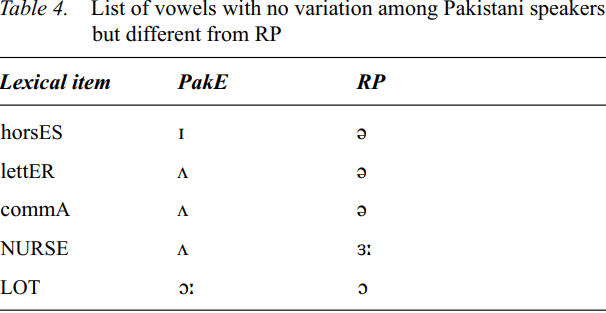


 Grammar
Grammar
 Tenses
Tenses
 Present
Present
 Past
Past
 Future
Future
 Parts Of Speech
Parts Of Speech
 Nouns
Nouns
 Verbs
Verbs
 Adverbs
Adverbs
 Adjectives
Adjectives
 Pronouns
Pronouns
 Pre Position
Pre Position
 Preposition by function
Preposition by function 
 Preposition by construction
Preposition by construction
 Conjunctions
Conjunctions
 Interjections
Interjections
 Grammar Rules
Grammar Rules
 Linguistics
Linguistics
 Semantics
Semantics
 Pragmatics
Pragmatics
 Reading Comprehension
Reading Comprehension|
Read More
Date: 2024-02-17
Date: 2023-05-02
Date: 2024-05-20
|
This group consists of vowels which showed no variation within Pakistani speakers, but differed from RP. Table 4 is a list of these vowels.

The first three words in this group are bi-syllabic. In RP, the second syllable is unstressed and, as a result of unstressing, the vowel is frequently reduced to [ə]. For example, RP speakers stress the first vowel and reduce the second to a lax mid-central vowel, schwa, in [letə] letter or [kɔmə] comma. Pakistani speakers did not reduce the vowel but rather used a full vowel, e.g., [lettΛr] letter or [kɔ:mmΛ] comma. Thus, there were no observed instances of schwa in the data collected using the Sheffield set (however, instances of /ə/ were observed in connected speech and will be discussed later).
The NURSE vowel is [Λ] and the LOT vowel [ɔ:].Their RP equivalents, [з:] and [ɔ], are not attested in the samples of PakE collected for this study. The tense midhigh central vowel [з:] is not attested in Rahman (1990) – see rhoticity for a discussion of Rahman’s work on PakE. Nihalani, Hosali and Tongue (1989) also do not list this vowel in their table of ‘Educated Indian English’ monophthongs. However, they do list the lax low back vowel [ɔ] in words such as cot and caught. Pakistani speakers in this study substitute [ɔ] with either a tense mid back vowel, [ç], as in LOT or a tense mid-high back vowel, [o:], as in CLOTH. It is possible to explain the absence of the vowels [з:] and [ɔ] by looking at the Urdu vowel system. Urdu does not use either of these vowels and thus it may be the case that PakE speaker replace these with Urdu vowels.
|
|
|
|
علامات بسيطة في جسدك قد تنذر بمرض "قاتل"
|
|
|
|
|
|
|
أول صور ثلاثية الأبعاد للغدة الزعترية البشرية
|
|
|
|
|
|
|
مكتبة أمّ البنين النسويّة تصدر العدد 212 من مجلّة رياض الزهراء (عليها السلام)
|
|
|